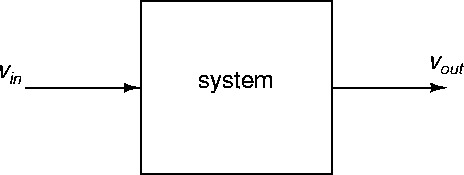 |
Consider the block diagram illustrated in Figure 44, showing an input voltage vin, and an output voltage vout. The block respresents a system, whose details we leave aside for the moment. The system could be a circuit, or a mechanical system, or... By the way, there is nothing special about voltages here, we could consider currents too.
The system performs some operation on the input to produce
the output. For example, the system could be an amplifier,
in which case the output is ideally an amplified copy of
the input. An input-output model H is a mathematical
operator or function which describes the behaviour of
the system:
An important type of input-output model for linear
systems is the transfer function H(s).
Here, s is the complex frequency used in the Laplace transform.
We write (53) in the more explicit form
In practice H(s) is found by calculating the ratio
Consider the RC circuit of
Figure 25, with R=1 ![]() ,
C=0.5 F, and
vC(0-)=0 V.
Let
vin=vg, and
vout=vC.
The s-domain circuit is shown in Figure 45.
,
C=0.5 F, and
vC(0-)=0 V.
Let
vin=vg, and
vout=vC.
The s-domain circuit is shown in Figure 45.
By voltage division we have


Notice that the transfer function is a rational function
of the complex frequency s. In general it has the form
The equation
The roots
![]() of the equation
of the equation
ANU Engineering - ENGN2211